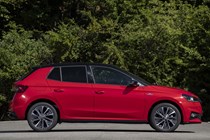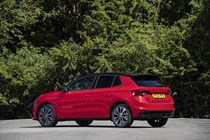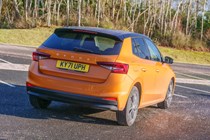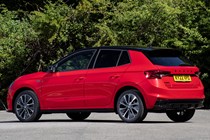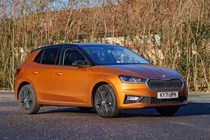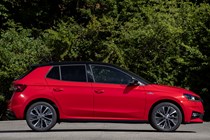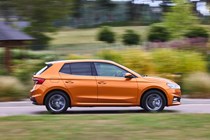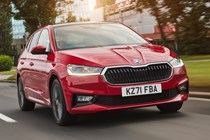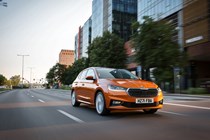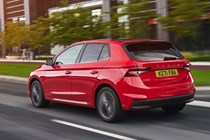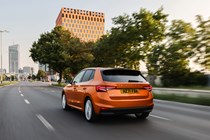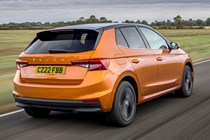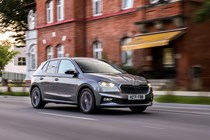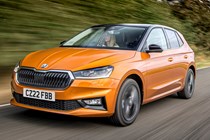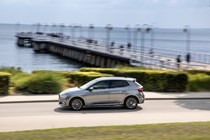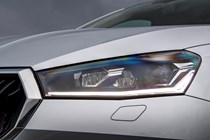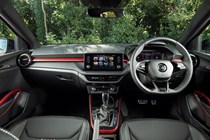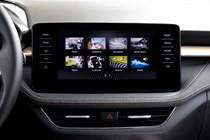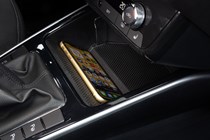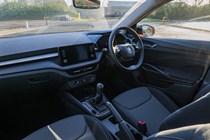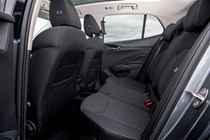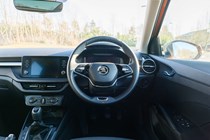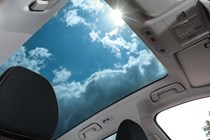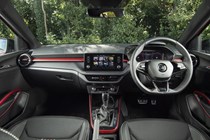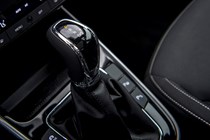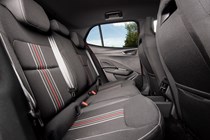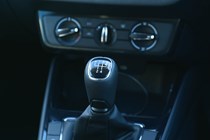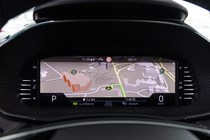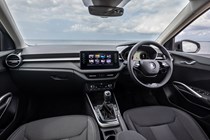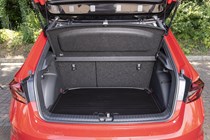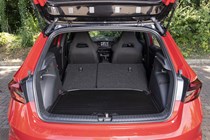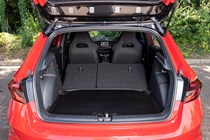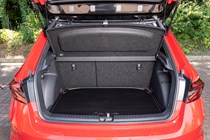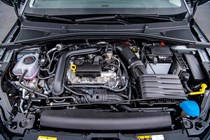
Skoda Fabia long-term test
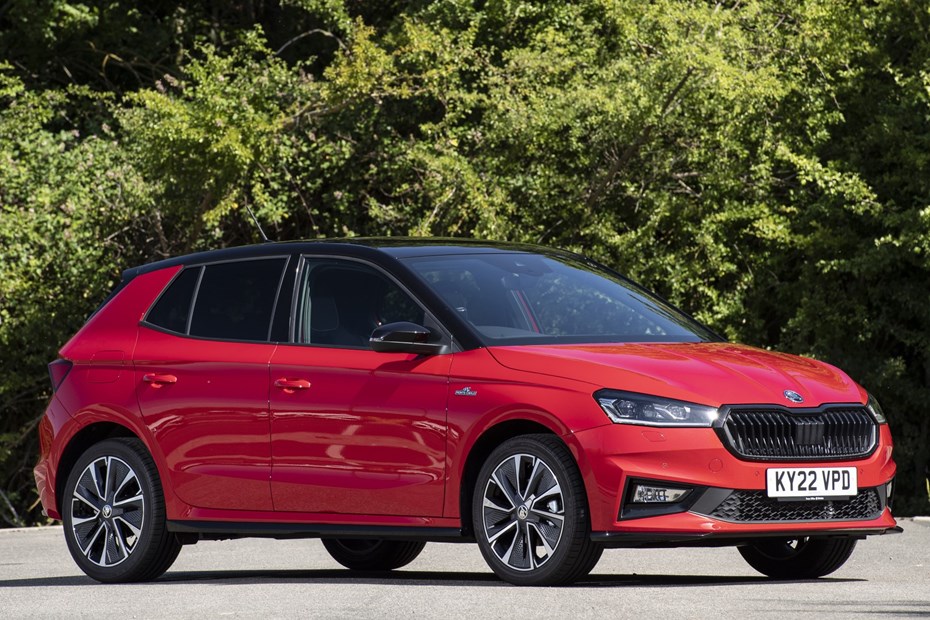

If you’re after a VW Group supermini, with plenty of space and a modest price tag, the Skoda Fabia is likely the way to go. To find out if it earns a place on your shortlist, Cat Dow is running one for six months.
- Update 1: Welcome
- Update 2: Hot engine, cool car, confusing tech
- Update 3: Frustration Stations
- Update 4: All the extras
- Update 5: What’s the Fabia’s fuel economy really like?
- Update 6: The Verdict: Is the Skoda Fabia worth buying?
Update 1: Welcome
When I was approached to take the Fabia long-termer, I didn’t need asking twice. My first car was a limited edition 1.3-litre Volkwagen Polo, inherited from my parents and I’d only recently sold a three-door Peugeot 108, in favour of a 1.6-litre Seat Ibiza estate, another VW group motor. Size-wise, the Skoda Fabia sits neatly in between the Pug and Seat; a five-door hatchback with space enough for the dog, our hiking paraphernalia and guests.
This Skoda Fabia SE L has a 1.0-litre TSI engine and six-speed manual transmission. It’s a smart-looking car; the Graphite Grey metallic finish and spoiler give it an acceptably sporty yet nicely understated presence. This is no doubt helped along by the 17” Procyon black metallic alloy wheels, a £470 optional extra.
During my six months with the car, I need to figure out whether the Skoda Fabia justifies its £23,695 price tag. The supermini segment is hugely popular with drivers both here in the UK and on the continent, accounting for around 20% of the vehicles sold in Europe.
Our narrow streets, tiny garages and narrower parking spaces are far less awkward when coupled with a city-friendly supermini. Generally, car makers have worked hard to make them as practical, comfortable and as spacious as possible. This gives them the versatility to stay nippy on city roads, yet manage motorway cruising without oodles of fuss.
What about the spec?
Recommended on-the-road prices for the Skoda Fabia start from £19,730. This particular spec, however, adds useful features, such rear privacy glass and wireless charging, as part of the Convenience Package (£600). The KESSY (Keyless Entry Stop/Start System) is implemented in a two-tier way.
Stop/Start comes as standard on the SE L trim and Keyless Entry with SAFE function, meaning no one can unlock the car from the inside by breaking a window, is part of the Convenience Package. In leaving the driver window open and reaching through to put something on the seat, I triggered the alarm (much to the chagrin of my neighbours at 6.30am on a Sunday morning). I can already testify the upgrade is a worthwhile consideration.
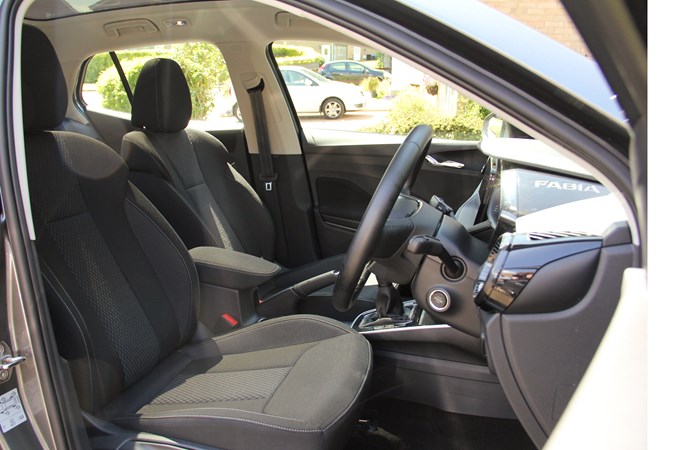
There’s a rather natty, albeit blind-less, panoramic sunroof (£745), parking assistance (£700) including a rear view camera and ‘Virtual Cockpit’ (£465) digital dials. These replace the speedo, rev counter and small digital display with one big and highly configurable screen.
With rivals in VW group siblings the Polo and Ibiza, then challenged by frugal Toyota Yaris, perennial bestsellers Ford Fiesta and Vauxhall Corsa, not to mention the Renault Clio, the Skoda Fabia undoubtedly faces some stiff competition. And we haven’t even touched on the new all-electric rivals hitting the market.
How’s it going so far?
A month in, I’m finding driving the Skoda Fabia dreamy. That six-speed gearbox is slick, quiet and the 1.0-litre turbocharged engine packs a surprisingly enjoyable punch. Around towns and villages, the Fabia handles nicely; confident in corners, nimble at roundabouts. The steering feels lighter than I’m used to, but it’s becoming more familiar and the design of the steering wheel itself is really comfortable.
The start/stop technology is appropriately responsive. I’m not going to lie; to quote Blur’s Parklife, ‘it gives me an enormous sense of wellbeing’ to not be sitting outside schools and public offices with an engine running.
Covering plenty of motorway miles each week, I’m a big fan of cruise control. The Fabia’s safety tech suite has lane-departure warning and assistance, but there’s no radar for adaptive cruise control functionality, i.e. the car won’t respond automatically to the speed of the vehicle in front. Nonetheless, cruise control is easy to initiate and adjust, via a designated stalk and the lane departure assistance isn’t overbearing. The whole package makes those ‘Average 50’ speed zones marginally more pleasant.
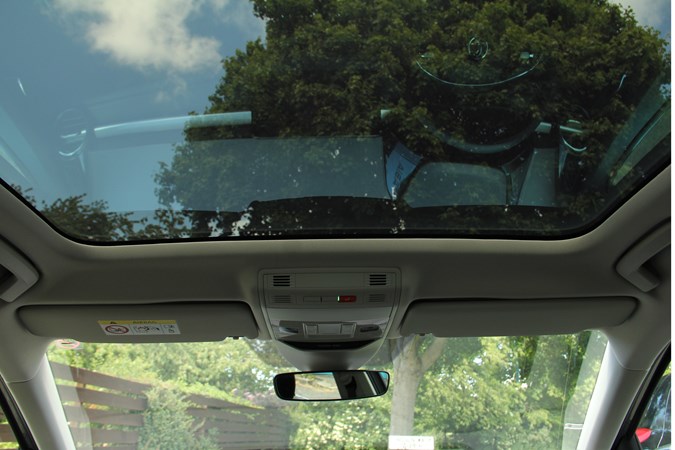
The interior really benefits from the panoramic roof. Whether it’s the feeling of being better connected with the environment, or the greater amount of daylight streaming in, the cabin feels almost lounge-like and super spacious. Though the seating padding doesn’t lend itself well to really long journeys, the comfort of the Fabia is more than adequate for knocking about town.
There’s plenty of actual space in the boot, too, and handy bag anchors for the groceries. The dog is happily and effortlessly secured in his crate on the back seat. What’s more, the quality of the sound system is decent—there’s four speakers in the front and two in the back.
Problems? I was barely out of the Parkers HQ car park before discovering my first niggle; the cupholders. Don’t laugh!
Both my 2011 Ibiza and the Fabia, over a decade younger, share similar design flaws when it comes to cup holder placement and size. Maybe it’s the Millennial in me, but I’m irked by the close proximity to the handbrake, interference with the arm rest and not to mention, the challenge to fit every (reasonable) size of reusable cup in there.
At this point, I suspect I’m in danger of being labelled a snowflake to deem such a minor inconvenience a dealbreaker. It’s not, for the record. Not least because only last week, I realised the cup holder sleeve is removable. In spite of my idiocy, I’m not convinced that’s really the solution, because…erm, hydration? And first impressions count. Right?
Fortunately, bigger bottles fit comfortably in the more expansive door pockets, so I guess that’s something.
I’m also experiencing a few frustrations with the tech, but I’m going to save that for next update. Frankly, in light of the cup holder revelation, the tech issues may be more user error than genuine criticism, so more investigation is needed. Stay tuned.
Update 2: Hot engine, cool car, confusing tech
After a spot of shopping the other day, I returned to the car, to find an Audi A3 and Renault Kadjar had sandwiched the recently polished Skoda on either side. Though the A3 carries a significantly higher price tag, the Fabia didn’t look a smidgen out of place. Holding its own without effort, like a rose in a bed of roses, I only wish I’d had my camera handy.
After style, the Fabia’s biggest pro is its driving experience. It’s quick off the mark, happy to corner tightly and doesn’t labour when more is asked of its 1.0-litre engine. In fact, I can barely believe the engine is so small, such is the impressive performance. We’ve had to cover many motorway miles over the past couple of months and not only is the car feeling more comfortable (familiarity?) but the routes have been beset with accidents, congestion, road closures, diversions and a raft of changing weather conditions. The Fabia’s smooth six-speed gearbox has made easy work of the hours spent tackling it all up and down from north to south of the UK.
Granted, the Fabia is not a huge car, so you’d expect some agility. But for a supermini, it really is generously spacious. The dog’s new crate is bigger. I had hoped to put him in the boot, since the lip of the Fabia’s upper boot shelf sits flush with the sill—perfect for him hopping in and out and a feature I really appreciate on muddier hiking days.
Unfortunately the boot wouldn’t close, due to the new crate’s slightly taller frame. While I could have lifted the upper boot shelf out, making the Fabia’s boot deeper and gaining those much-needed centimetres, I thought it’d be cleaner to have him jump straight in. So he’s comfortably ensconced across the rear seats, leaving plenty of room for two other passengers.
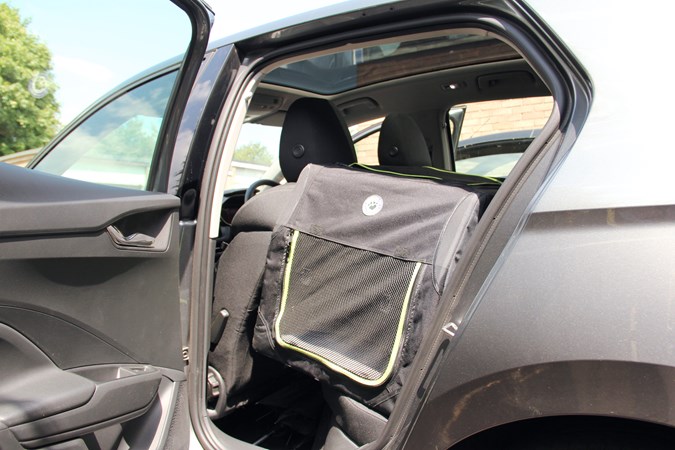
The Fabia’s engine never grumbles and despite the jaw-dropping escalation of fuel prices, the Fabia is not especially thirsty either. The miles-per-gallon reading has been around 43mpg. This is a bit on the low side of the manufacturer’s broad claims of 42.1-63.7mpg.
That said, I have used the air-con (though studies have shown this barely makes a decent in the fuel, around 3mpg). I’ve cruised at the limit on most longer journeys, so I’ll work to see what’s needed to economise over the next couple of months.
I do wonder if the climate control has to work harder with that panoramic roof. It’s beautiful to look at, and when the cabin is comfortable, adds an enormous sense of capacity. Still, it acts like a glass house and getting into the car on a sunny day can be uncomfortable until the cabin is at temperature.
While the air-conditioning is quick to cool, the mixture of using semi-physical switchgear and touchscreen controls doesn’t quite work as smoothly as it should. I’m a big advocate of real buttons for climate control, since it’s the kind of feature you adjust while travelling and ideally, cabin designs that minimise driver distractions are favourable.
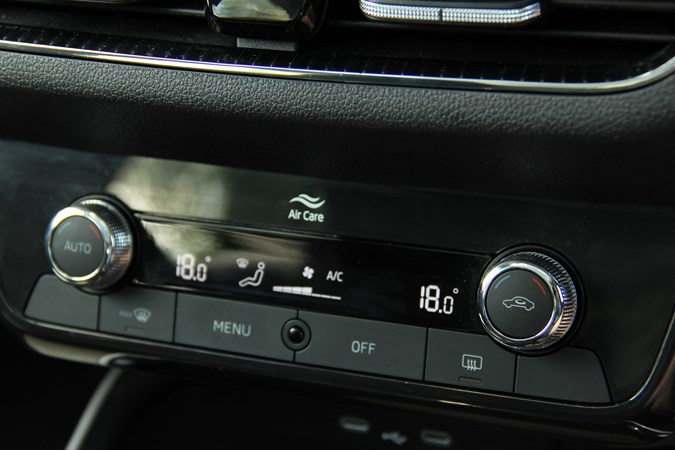
Unfortunately, the fan speed is only accessible in the digital menu, which has glitched a couple of times. This means the whole infotainment system needs to be turned off and back on again. The fan adjustment when it’s programmed to ‘auto’ as opposed to ‘manual’ isn’t especially responsive and the dropdown needed to switch between manual and auto is fiddly and distracting. The ‘air care’ setting enables you to initiate the filter, which is great idea for allergy sufferers in high pollen conditions. However, it needs to be selected every single time you start the car. The preference isn’t saved, which seems odd.
Frankly, the HMI, which is techie speak for digital interface (it means human-machine-interface) isn’t great. Good HMI design relies on making sure all choices are minimised/simplified as much as they can be and where possible, one-step taps/clicks get you to the feature you desire and operate it immediately.
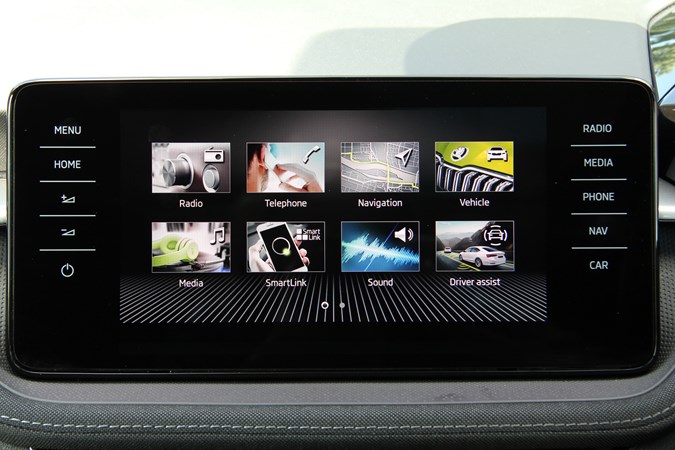
The semi-physical shortcut buttons on the side of the Fabia’s screen help drivers navigate quickly to specified menus and are a means to build driver muscle memory. With familiarity, ergo, drivers ought to be able to select a button without needing to look where it is.
Overall, Skoda has done a pretty good job . If you want a radio stations, hit ‘Radio’ and the swipe-friendly touchscreen will help you toggle between your preferred channels—we’d definitely recommend setting up your Favourites, which is pretty easy to do.
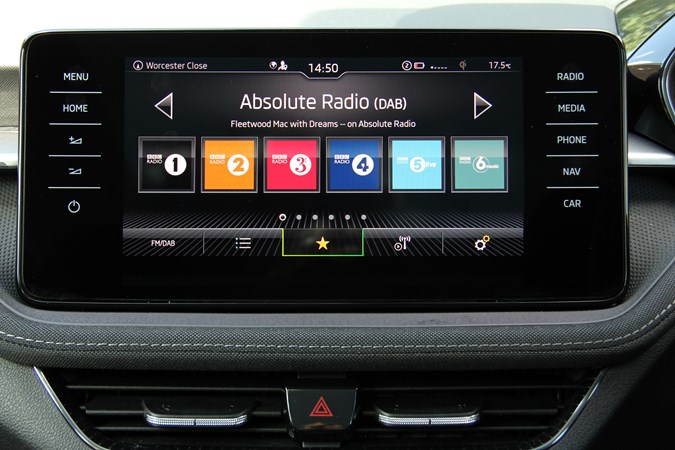
In much of the digital interface, however, Skoda has over-complicated matters. For example, ‘Vehicle Settings’ lets you reset the tyre pressure monitoring sensors, often found on the steering wheel controls in other vehicles. The Virtual Cockpit—a feature Skoda really highlights as a plus, as it enables you to customise the display directly in front of the driver—is another dropdown menu within this Settings menu. Meanwhile, other parts of VC can be controlled from the steering wheel buttons.
We tend to see these kind of design inconsistencies when brands approach the menus, features and shortcuts from the point of view of a tech-savvy engineer, not an average driver. They will understand their own logic, but what about the rest of us?
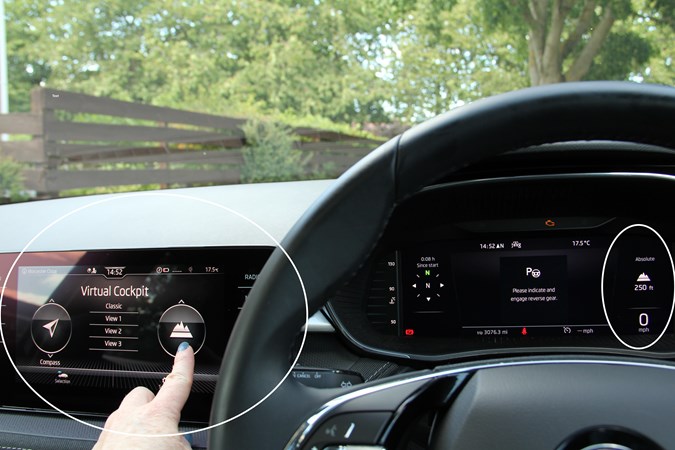
Frankly, VW and Skoda could have done better here. Unsurprisingly, Apple Carplay and Android Auto integration will appeal to many drivers familiar with these interfaces and so the Skoda system is arguably redundant. However, connecting to Android Auto wasn’t the greatest experience either. More on that next update.
(Ps. I include images to show my cupholder frustrations are not totally unfounded.)
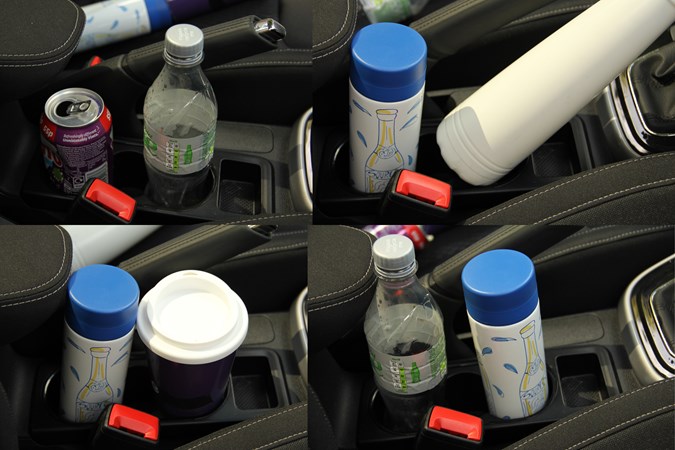
Update 3: Frustration Stations
Last month, I touched on the difficulties I was having with the in-cabin technology of the Skoda Fabia. Almost 12 weeks on, and frustrations have developed into a deep mistrust of the voice control and the navigation.
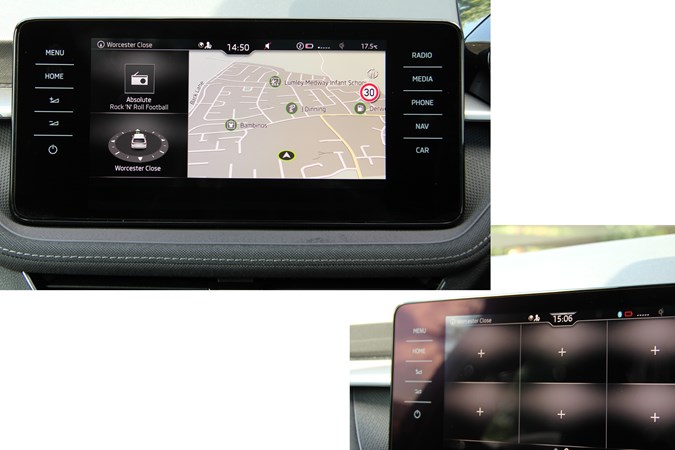
Voice control
Having tested car infotainment technologies for almost a decade now, I’m pretty familiar with most systems. I use voice control, because like Alexa in the Home (and now more recently ‘Amazon Alexa Auto’), you can get stuff done without taking your eyes off what you are doing. In this case, the road is the priority.
I also like to avoid touching the buttons while I’m driving. When you step in and out of different cars for a living, and there is no standardisation of these tech features, you tend to find you never find the buttons in the same place you left them. Yet, very few manufacturers have truly nailed an adequately functioning voice control system.
Some, like the Mercedes Benz MBUX system are terrific, others like JLR’s InControl are decent, but sometimes overzealous – hearing a wake word and activating when no one’s spoken. This Skoda integration is well down the list from here.
Initiating voice control from the button on the steering wheel isn’t always successful. Just when you might have given up, it kicks in and asks which menu you want. If you get over this lag, for telephony commands, such as ‘Call Grandma’, it’s spot on. Responding quickly, it’ll give you a choice of line numbers if you have more than one number stored.
The reception I’ve had in the car however has been poor. Since I do a lot of miles during office hours, I tend to make business calls from the car. The shark fin antenna is supposed to strengthen the mobile signal when connected. I can’t say I’m feeling any of those benefits. I’ve even spoken to my network provider, just in case, but when I step back into my Seat, there’s a definitive difference in call quality.
(For the record, I’m postive it’s not my weird quasi-Northern accent because I’ve mastered the mimicry of flawless RP, sweetie darling.)
Navigation
Trying to set the navigation with voice control is a mission, demanding information I shouldn’t need to provide. Since the sat-nav has also sent me on a wild goose chase a couple of times, I’ve almost abandoned all efforts to use the proprietary system.
I’ve tried to work out what has been happening here and I think it might be something to do with the touchscreen technology. It senses when my finger is near and I suspect it’s dropping a pin. That said, I categorically had the experience without being anywhere near the centre display. Skoda says the system will re-route to avoid congestion, but these incidents seem to be a complete change of destination.
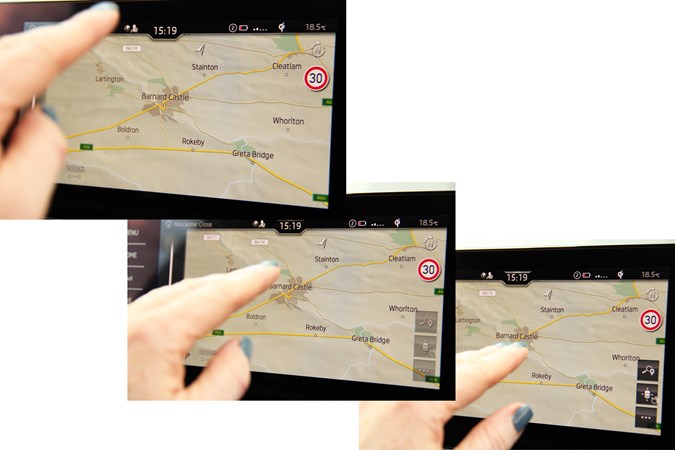
Phone mirroring you say? Using Android Auto left me with a phone battery fit to pass out, despite being on the Skoda’s wireless charging pad for the whole journey. Battery charging aside, though, connecting to Android Auto is a better experience when it comes to both navigation, voice control and having a wider choice of media during the journey.
What else?
The Fabia has its own 4G SIM, so it can act like a mobile Wifi hub. This means you shouldn’t need to use your phone’s mobile data. As mentioned, cars are equipped with bigger and better antenna technology, the signal should be stronger.
However, Skoda admits the Wifi can struggle to connect if the signal is poor regionally. I do live in one of those areas, but having tried in various locations, I haven’t yet been able to get my mobile device to hotspot to the Skoda.
Of course, there’s also the mind-boggling layout of the menus on both the centre display and cluster display that I mentioned last update.
What does this mean for you?
While these tech issues won’t stop you from driving the Fabia, they could affect your enjoyment. I’ve definitely been frustrated when I’ve been late to an appointment because the sat-nav randomly switched things up. But if tech is not important to you or you are happy to rely on cabled charging and Auto or CarPlay, these issues will be less of a concern.
Does they compromise the value for that price point though? I haven’t yet made my mind up. Stay tuned for next month’s update.
Update 4: All the extras
In almost six months, I haven’t rated the Fabia for its innovative tech provision (I documented the frustrations I’ve been having with various features above). Disappointingly, certain issues continue to persist that even familiarity can’t allay. The Skoda Fabia is, however, pretty unique in the market for its accessories.
Very few models on the market claim to offer a branded umbrella…if they’re not Rolls Royces and Bentleys at least. The Fabia may share this quirky in-built feature with all its siblings, including the Skoda Kodiaq, Superb, Scala (and I also have it on good authority (see: Tom Wiltshire) that Nissan had one on the Pulsar in the 1990s), but Skoda is the only mass-market manufacturer to do this currently.
Though Porsche and Aston Martin have been known to dabble in signature brollies for a pretty penny or two, the whisper of velcro attachment is, however, a far cry from the handy door pocket the Fabia has.

The quirks don’t stop there either. Skoda has also integrated an ice scraper into the door of the fuel port. It’s ingenuous. Why hasn’t this been done sooner?!
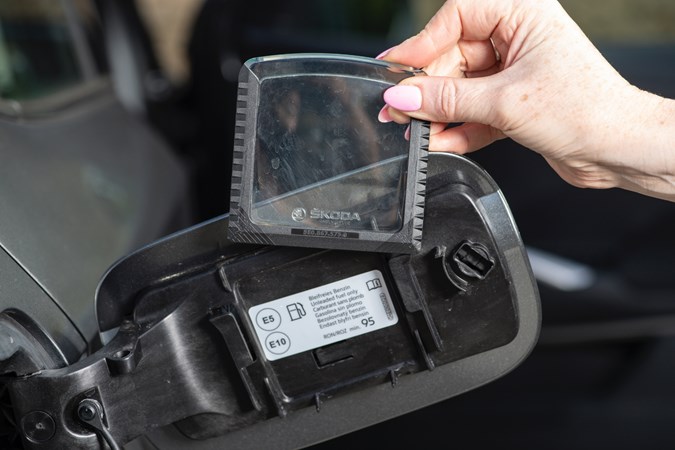
Trying to figure out which optional extras you should plump for is a nerdy exercise in cost-benefit analysis. While some options add value and help maintain the residual value of your car when you come to sell it on, others provide little value, cost a lot and don’t necessarily justify the initial outlay.
(A really good example is gesture control in the BMW 5-series. Being able to control the volume or answer calls without touching the controls is funky, but it’s not a reliably consistent performer. That’s not to say all gesture control is redundant; huge fan of handsfree boot lids here. But, I digress…)
Back to the Fabia, these accessories are available as standard from the SE Comfort trim, where prices begin from £17,800. Coupled with the impressive fuel economy, which I’ll detail later this month, we’ll soon be concluding our time with the Fabia and crunching our numbers to figure out what the best combination of options might be. There’s no denying, however, that with the Fabia, I’ll never forget my umbrella again!
Update 5: What’s the Fabia like for fuel economy?
Getting a car with great fuel economy has never been more necessary than it is today. Over the course of the time I’ve spent with the Skoda Fabia, the political landscape – both nationally and globally – has become more fractious than usual, impacting the cost of living.
Escalating fuel prices are finally beginning to drop to more reasonable levels, though at the time of writing, the motorist was still being overcharged and the government was in a state of unimaginable flux.
Fortunately, the fuel economy in the Fabia has been much better since I promised you I’d pay more attention. I’ve already enthused about the engine performance, but I’d struggled to see anything near the peak delivery of 49.4 – 63mpg suggested by the manufacturer. A discrepancy between claims and real-world performance is nothing new, but the Fabia has been more consistently delivering 39-42mpg. Quite a margin.
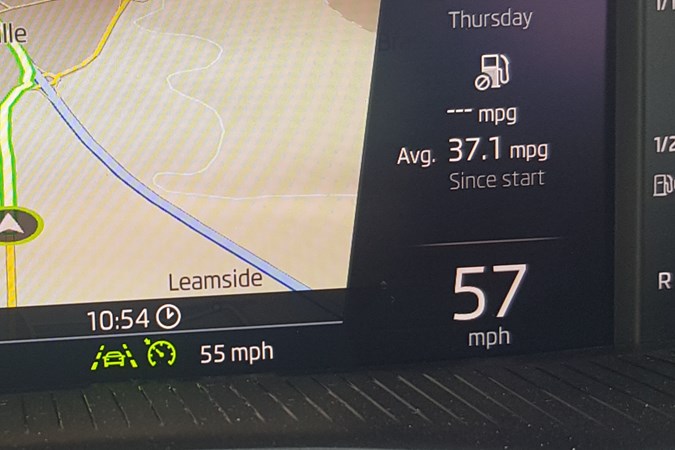
Dismayed (and aware I have a heavy right foot), I’ve spent the last couple of months, like many motorists, driving a lot more mindful of how quickly I’m trying to accelerate. And it’s paid dividends. Driving more economically has seen me squeeze an impressive 58.7 at times, but more consistently, it’s been around the 48-52mpg mark – much closer to Skoda’s claims and better for my wallet.
There’s a number of things Skoda has done to make this little hatchback more fuel efficient – one being to reduce the drag by making the Fabia more aerodynamic. This has included putting Skoda-branded wheel covers on the 17” alloy wheels.
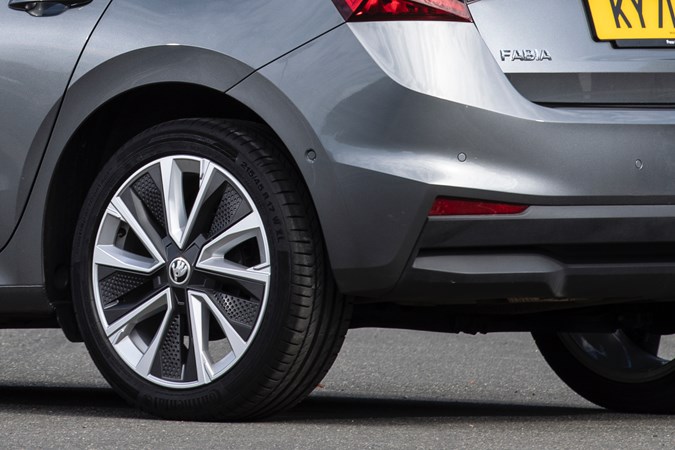
I wanted to check how easy it would be to change the wheel, in the event of a flat (after all, practice makes perfect). The wheels have been one of the toughest things to clean, with the 17” Procyon fancy alloy design (I’m committed to handwashing, since I lack an outdoor tap).
Skoda has the whole kit and caboodle for switching the spare tyre under the lower boot liner. Including the locking nut, it was great to see everything in one place, and really easy to find on a rainy afternoon when a breakdown is the last thing you need hassle with.
Removing the wheel cover however was the biggest challenge. I don’t consider myself especially weak (Okay, okay, shout out to my neighbour who regularly helps me out with pesky jam jars) but I didn’t want to damage the cover either. It’s plastic and anchors on with plastic clips. I pulled and pulled and then panicked. I wasn’t actually needing to change the tyre, but I certainly wouldn’t have liked this trouble on the roadside.
With a deep breath, I yanked one more time, mentally accepting the cost of a new plastic cover was a worthy price for research purposes. Success! Ooh, it was tight and I questioned the decision to put a cover on wheels you’ve paid extra to upgrade to. On a better note, it was easy enough to put back on and no wheel covers were harmed in the testing of this car.
The next and final installment will assess whether living with the Fabia makes good on its price point.
Update 6: The Verdict: Is the Skoda Fabia worth buying?
After six months and almost 7,000 miles, the Fabia has shown itself to be comfortable and capable. I’ve waxed lyrical about the driving experience. Frankly, if you’re looking for a rebellious hot hatch with plenty of punch, the Fabia will disappoint. But if you’re after a small hatchback with enough power to make driving a pleasure, get you from A to B comfortably and safely, and carry reasonable motoring costs, you can’t go wrong with the Fabia.
The interior is pleasantly spacious and over the test period, I’ve gotten used to the feel of the driving seat. That familiarity has brought more comfort, especially on longer journeys. The amount of luggage space has been more than adequate for the weekly grocery shopping, work travel and extensive UK adventures with friends over the summer. The Fabia is deceptive in just how capacious it really is.
There are justifiable criticisms to level at Skoda for the cabin tech. Menus within other unfathomable menus coupled with infrequent but frustrating glitches aren’t the quality I’d expect from a VW Group brand – especially one that, in other ways, has shown itself so future-forward.
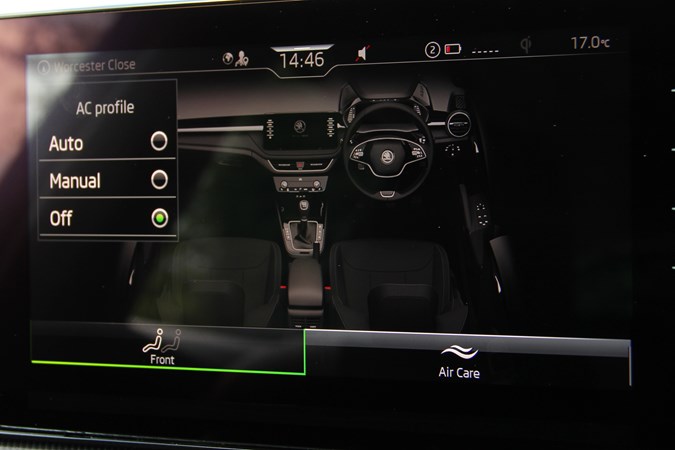
I’ve persisted with the proprietary navigation, albeit reluctantly. The lack of 4G connectivity (which is meant to be available, but I simply couldn’t get it to work) has meant the estimated time of arrival (ETA) has been as much as 20 minutes out, when compared with Google Maps. No doubt a discrepancy caused real-time traffic or roadworks – I’ve been caught out twice with motorway closures, adding serious miles and time to already-long journeys. This is demonstrative of how helpful a decent internet connection can be on long car journeys.
I don’t think these tech niggles are sufficient to completely write the Fabia off your shortlist though. Firstly, tech is a funny thing on loan cars. Data regs (GDPR) means we’re not always able to act exactly like an owner with full control over the software sign-in, the system and the companion app. Secondly, the media and telephony features have worked well enough – the reception did improve on trips to London.
I can’t praise the Fabia’s practicality enough, detailing its accessories in Update 4. These coupled with the sophisticated driver aids; the Park and Go Package Plus, cruise control and active lane-keeping are worth the investment.
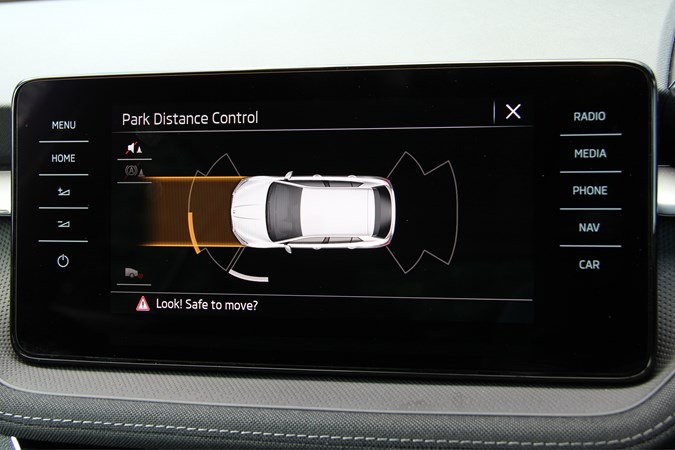
Bearing this in mind, would we pay £23,695 for the Fabia? In short, yes.
If your budget didn’t stretch quite that far, the £1,215 +VAT committed to the alloy wheels and panoramic roof are two areas where you could slim that total. But that would impact aesthetic appeal, driving experience and potential residual values. In fact, I would be persuaded to spend more and get the roof blind, to try and manage the cabin comfort on hotter days.
While £465 on the Virtual Cockpit might sound wasted, if you’re not especially tech-savvy, in fact, I was surprised by how much I relied on this. There’s a compelling argument that the less au fait with tech you feel, the more you need to invest in it. It’ll also make more sense to have this when you come to sell.
Looking at the other upgrades on this Skoda Fabia, wireless charging provides such convenience (I haven’t had to faff with cables in the car) to skimp on a mere £55 at this stage would feel like a drop in the ocean. It also helps free USB-C ports for connecting other devices, like dash cams. And did you know, having advanced driver assistance systems (ADAS) can help you save money on car insurance?
Skoda offers, in the Fabia, a package that is really tough to beat, value-wise. Throw in some satisfactory fuel economy figures and the value-for-money reputation that the Fabia has garnered is hard-earned and well-deserved. So much so, it’s won Parkers’ award for First Car of the Year 2023.



